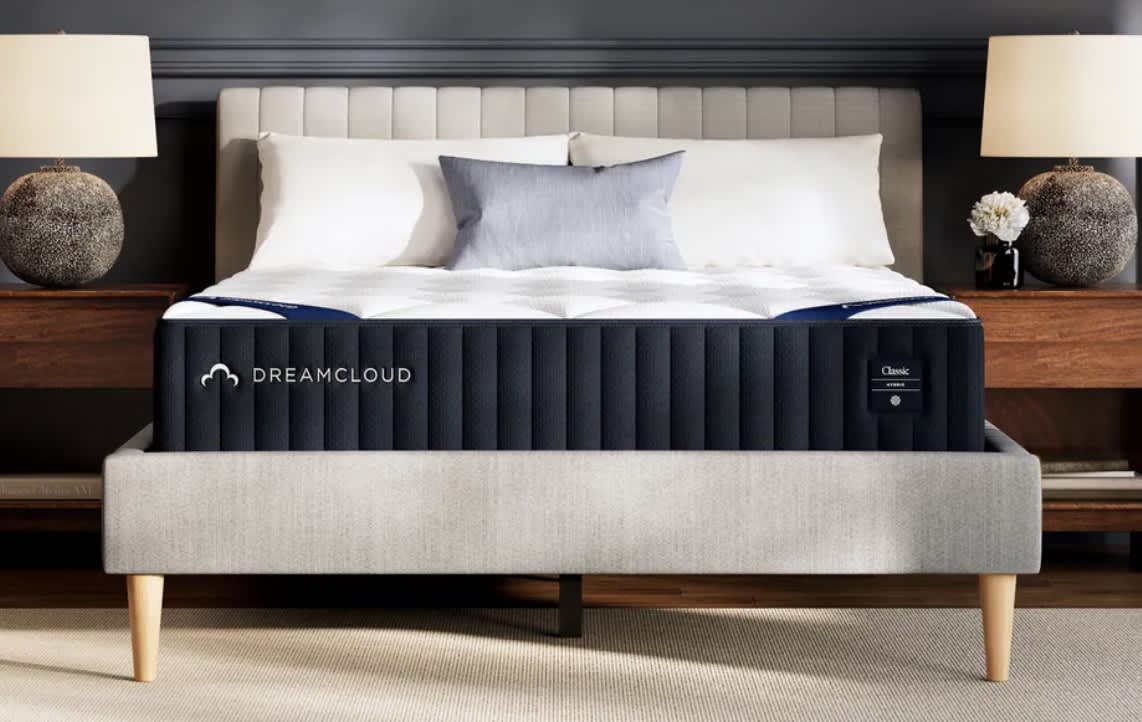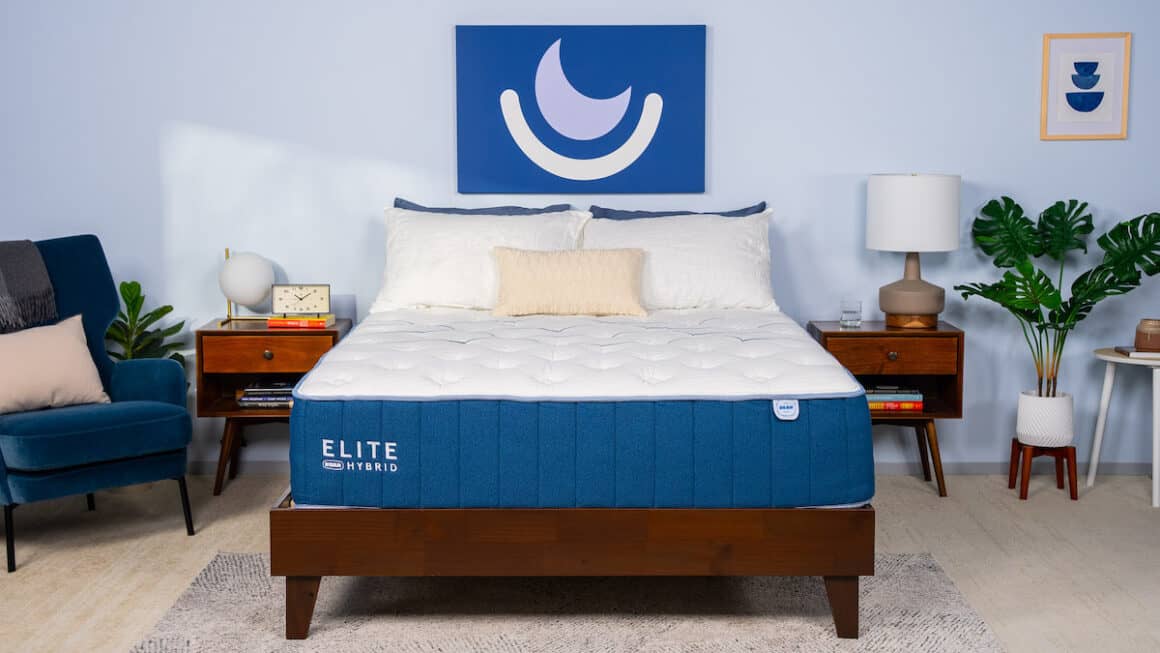On This Page
The Best Mattress for Hip Pain
Our Top Picks
-
Best Overall Mattress
Softer WinkBed -
Best Mattress for Side Sleepers
Helix Midnight Luxe -
Best Value Mattress
DreamCloud Classic Hybrid -
Best Mattress for Pressure Relief
Bear Elite Hybrid -
Best Temperature-Regulating Mattress
Brooklyn Bedding Signature Hybrid
Best Overall Mattress
The Softer WinkBed is plusher and more adaptive than most competing hybrids, and this level of contouring can greatly benefit people with persistent hip pain. Side sleepers on our team were particularly impressed with the cradling, cloud-like feel of the mattress.
Pros & Cons
Pros
- Polyfoam layers contour closely to the hips to reduce impact and promote spinal alignment
- Zoned coils prevent excessive sinkage into the mattress
- Breathable and moisture-wicking Tencel cover helps keeps the surface cool
Cons
- Limited edge support compared to firmer WinkBed models
- May feel too soft for back and stomach sleepers over 230 pounds
Ratings
Our Take
Best Mattress for Side Sleepers

The Helix Midnight Luxe hits that sweet spot between close contouring and sturdy support, making the mattress a top choice for people with persistent hip pain — side sleepers in particular. A responsive surface and reinforced perimeter also help you move across the mattress with ease.
Pros & Cons
Pros
- Adaptive foam layers cushion sore spots without hugging too closely
- Reinforced perimeter coils prevent deep sinkage when you get in and out of bed
- Two cooling cover options
Cons
- Not supportive enough for most back and stomach sleepers over 230 pounds
- Foam layers may produce strong initial off-gassing odor
Ratings
Our Take
Best Value Mattress

The DreamCloud Classic Hybrid’s balanced construction should appeal to anyone who needs close contouring for their sore spots and sturdy support to prevent excessive sinkage. We also recommend this mattress to shoppers with limited budgets — given the luxurious hybrid design, its sticker price is very accessible and the yearlong sleep trial is much longer than average.
Pros & Cons
Pros
- Plush foam layers promote even alignment and cushion your sore spots
- Robust pocketed coils provide pushback to keep your body on an even plane
- Each order includes a 365-night trial and return period
Cons
- Strong off-gassing smells may be present for the first 72 hours
- Stomach sleepers over 230 pounds may sink too much
Ratings
Our Take
Best Mattress for Pressure Relief

Hip pain and pressure buildup often go hand in hand, and we’ve found the Bear Elite Hybrid’s foam-over-coil design is effective at alleviating both. A plush surface reinforced with multi-zone support layers provides a nice balance of cushioning and stability, and you can choose from three firmness levels for optimal comfort no matter what you weigh or how you sleep.
Pros & Cons
Pros
- Adaptive foam layers cushion and cradle the body to alleviate sore spots
- Multi-zone transitional foam and coils reinforce heavier areas of the body
- Three firmness levels to accommodate different sleeper types
Cons
- Off-gassing odor is fairly harsh for the first few nights
- Limited options for people seeking an exceptionally soft mattress
Ratings
Our Take
Best Temperature-Regulating Mattress
Foam bed surfaces are great for pressure relief but are also known for trapping heat — which is why the Brooklyn Bedding Signature Hybrid is a strong pick if you want the cushioning of foam minus the heat retention. You get strong ventilation through a coil layer, and for an extra cost you can add a pillow-top with specialized cooling features.
Pros & Cons
Pros
- Sturdy coils and polyfoam layers offer even balance of support and cradling
- Optional pillow-top features a cover made with cooling fibers
- Available in three firmness options
Cons
- $99 fee for all returns
- Foam may release off-gassing odors for a few days
Ratings
Our Take
Compare Our Top Picks
| Mattress | Mattress Type | Ideal For | Value | Sleep Trial |
| Softer WinkBed | Innerspring | Lighter Sleepers | Good Value | 120 nights (30 night requirement) |
| Helix Midnight Luxe | Hybrid | Combination Sleepers | Good Value | 100 nights (30-night requirement) |
| DreamCloud Classic Hybrid | Hybrid | Combination Sleepers | Great Value | 365 nights (30-night requirement) |
| Bear Elite Hybrid | Hybrid | People With Back Pain | Good Value | 120 nights (30-night break-in period) |
| Brooklyn Bedding Signature Hybrid | Hybrid | Couples | Great Value | 120 nights (30-night requirement) |
Video: Is Your Mattress Causing Hip Pain?
Is Your Mattress Causing Your Hip Pain?
Most of the time, hip pain is caused by an underlying health issue, like a bruise, a pinched nerve, or arthritis. However, an uncomfortable or unsupportive mattress can exacerbate hip pain.
Some signs that your mattress may be contributing to hip pain include:
- Pain that is worse when you first get out of bed
- Difficulty getting comfortable at bedtime
- Waking up frequently during the night
- Emergence of other aches and pains, which may arise from trying to compensate for hip pain in bed
How Does Sleeping Position Affect Hip Pain?
Sleeping position can affect hip pain because it influences the amount of pressure and impact placed on your hip joint. If you’re a side sleeper and experience hip pain on only one side, try sleeping exclusively on the other side. Experts also suggest sleeping on your unaffected side with a pillow between your legs.
Though back sleeping doesn’t put as much pressure on the hips, it’s important to use a mattress that provides sufficient support with enough cushioning to feel comfortable. Likewise, though stomach sleeping generally isn’t recommended, it’s essential to sleep on a supportive mattress that prevents the torso from sinking excessively.
When I’ve got a sore hip, I find that since I’m primarily a side sleeper, placing a pillow between my knees and switching the side I sleep on goes a long way to relieve the pressure on the affected hip. If the pain is especially troublesome, I prefer to switch to back sleeping with a bolster pillow under my knees.
Tips for Changing up Your Sleeping Position
If you need to change your sleeping position to decrease impact on your hips, try using pillows to bolster your body in your new position. Extra pillows can also make your adopted sleeping position more comfortable. Another approach is to sew a tennis ball to your pajamas to prevent you from reverting to your accustomed sleep position.
How to Choose a Mattress for Hip Pain
When choosing a mattress for hip pain, you can zero in on a high-performing model by thinking about things like mattress type, firmness, cushioning, pressure relief, and support.
Mattress Type
Materials and construction drive mattress performance and are the basis for categorizing mattresses into types. Foam mattresses have a base of dense polyfoam beneath one or more layers of memory foam or another softer foam. These mattresses generally contour to the body to relieve pressure and avoid excess impact around the hips.
Latex mattresses have multiple layers of latex, with a top layer that generally provides more pressure relief. The bounce and pushback of latex typically makes these mattresses excellent for people who want to avoid feeling stuck in place on their mattress.
In hybrid mattresses, a support core of individually wrapped coils rests beneath layers of memory foam, polyfoam, microcoils, latex, or other materials. The thick coils provide stability and responsiveness, while the comfort layers offer cushioning for pressure points.
Airbeds have inflatable air chambers that allow the firmness level to be modified via a remote control or smartphone app. Additional materials layered above the air chambers can enhance contouring or bounce.
In general, we recommend that people with hip pain avoid traditional innerspring mattresses. Unlike hybrids, innersprings have almost no material above the coils to cushion the body, making them more likely to exacerbate hip pain.
Firmness Level
Firmness, which is how hard or soft a mattress feels, is a key element of your comfort and sleeping experience. If a mattress is too firm, it can generate painful impact around the hips. If a mattress is too soft, the hips or lower back may sag out of alignment with the rest of the body, putting stress on the spine.
The ideal firmness level for hip pain depends on body weight, sleeping position, and individual preferences. Side sleepers normally need a softer mattress than stomach or back sleepers, and that’s especially true when the hips require more cushioning. Typically, people under 130 pounds benefit from a softer mattress, while people over 230 pounds need a firmer one.
Cushioning and Pressure Relief
Cushioning materials like foam and latex provide softness around the hips to prevent pain from worsening. Pressure relief refers to the ability of a mattress to soften impact in key areas while encouraging spinal alignment. For people with hip pain, this means that a mattress avoids strain or pressure at the hips but still supports the body’s overall posture.
Zoned support is a design feature that gives different levels of cushioning or pushback in different parts of the mattress. Many mattresses provide reinforced materials around the midsection, which can enhance spinal alignment and pressure relief for people with hip pain.
Tips for Relieving Hip Pain at Night
A handful of practical tips for people with hip pain may help make nightly sleep more comfortable and restorative.
Add a Mattress Topper
A mattress topper sits atop your existing mattress and can adjust firmness, pressure relief, or bounciness to make you more comfortable in bed. If you have hip pain and can’t afford an entirely new mattress, a topper with extra cushioning can be a cost-effective way to soften impact around your hips.
Practice Good Sleep Posture
Good sleep posture means that you aren’t contorting your body or placing excess strain on any specific area. No matter what sleeping position you prefer, first position your body evenly and naturally and then gradually adjust your posture to eliminate twisting or stress. An extra pillow may help you settle into a proper sleep posture.
Use Pillows Strategically
If you are a side sleeper, a pillow placed between your knees may reduce strain on your lower back. A larger body pillow can be used to maintain a comfortable position through the night.
When sleeping on your back, a pillow under your knees can lighten the load on your lumbar spine and midsection. On your stomach, you may benefit from a thin pillow under your midsection.
You should also pay careful attention to the pillow for your head. Finding the best pillow for your sleep position with the right height prevents excess bending that can cause your neck to be stiff or painful.
Consider Speaking With Your Doctor
Talk with your doctor if you have hip pain that is persistent, worsening, or severe. Because hip pain is usually linked to another health issue, a doctor can give the best advice for addressing hip pain and getting better sleep when dealing with hip pain.
Discover More Mattress Solutions
If a friend or family member needs a mattress to help with a different condition affecting their sleep, check out our curated mattress picks for specific needs.
More Mattress Options for Specific Needs
How We Test
Our recommendations are built on years of industry experience and an in-depth research and testing methodology. We determined the best mattresses for hip pain in our testing lab by personally assessing dozens of mattress types and models and analyzing how they affect pressure and support in the context of hip discomfort.
We put these mattresses through both objective and subjective testing. Our testing team includes sleepers with a variety of comfort preferences, sleeping positions, and body weights, which enables us to understand how a mattress will perform for various types of sleepers. We also read reviews and collect survey data from verified mattress owners to determine the best-selling mattresses for hip pain – this helps us confirm our team’s lab results are consistent with real-world experiences.
Frequently Asked Questions
The best firmness level depends on the cause of hip pain as well as a person’s weight and sleeping position. A softer mattress can cushion a side sleeper’s hips and reduce pressure that can contribute to hip pain. However, if the mattress is too soft, the body can sink too far into the bed and misalign the spine.
A firm mattress can increase impact at the hips and worsen pain, but it may also encourage better overall sleep posture for back and stomach sleepers and people over 230 pounds.
The best mattress for hip pain has a balance of pressure relief and supportiveness. It should have enough cushioning to make sure there’s no uncomfortable impact against the hips. At the same time, it should accommodate the body across the mattress surface to keep the spine in a neutral position.
Memory foam is often good for addressing hip pain. This material is known for its contouring, which allows it to soften impact around the hips. However, for stomach and back sleepers with hip pain, softer memory foam mattresses may allow too much sinkage to keep the spine properly aligned.
If a mattress generates extreme pressure against a hip joint, it is possible for it to cause discomfort, but in most situations, hip pain begins with an underlying injury or medical condition like bruising, swelling, arthritis, or nerve damage.
The best sleeping position for hip pain depends on the nature and cause of the pain. Often, pain may be reduced by limiting the amount of weight and impact placed on the painful hip. In these situations, sleeping on your back or on the other side from the pain may help.
